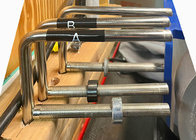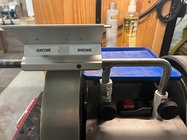I have the set of all 3 diamond grindstones: DC-250, DF-250, & DE-250. I use them for sharpening my turning and other woodworking tools mostly, and the occasional knife. What is great about them for the turning tools (and drill bits) is that you can swap out the grinding wheel without have to re-setup the universal support bar (USB).
I use the DF-250 about 90% of the time.
- Regarding the DC-250: I added a BGM-100 to my bench grinder, and that is what I use most often when major reshaping of a tool is necessary (unless the tool is not high speed steel). This is why I use the coarse wheel so little.
- I will use the DC-250 on a drill bit if is in rough shape. It works well for that, and I can quickly jump to the DF-250 for the next step of sharpening.
- I also use the DC-250 when major reshaping is needed on steels which are not high speed. Some examples include new carving tools, and chisels which have nicks in them.
- Regarding the DE-250: This is great for bench chisels. Gets them really sharp, and provides a great edge quickly. You can use a finer stone to hone more if necessary.
- I also have the SJ-250 Japanese water stone. If you are honing an edge, This is a good next step before using the SJ-250.
- Alternatively, you can hone the edge using paper wheels on your bench grinder (e.g., https://www.sharpeningsupplies.com/8-x-58-Paper-Wheel-Sharpening-Kit--P1144.aspx). I find this is great for the skews and spindle gouges, especially on the final passes of your work. Leaves a surface that is glass-smooth.
- The DE-250 is great for the primary facet on a drill bit, especially smaller bits. Gives a very smooth edge.
One thing which I have implemented (and recommend) is the use of dedicated USBs:
- One for use with the TTS-100 at the A Setting. I lock this in using a collar, not using the nut. By the way, the US-105 for the smaller Tormek works fine for this.
- One for use with the TTS-100 at the B Setting.
- One with an SVD-110 tool rest locked into position for resharpening skews (I primarily use the Alan Lacer skews and sharpen them at 40°). I removed the knob and lock it into place with set screws.
- One with an SVD-110 tool rest locked into position for resharpening scrapers (I have my scrapers sharpened as negative rake, with both sides the same angle, 22.5°).
I leave the DF-250 on the machine, and simply drop the desired USB into the machine, resharpen, and get back to work.


